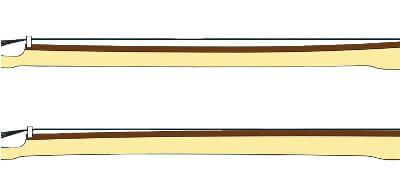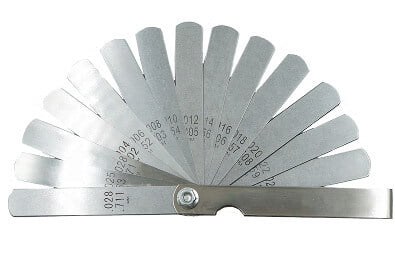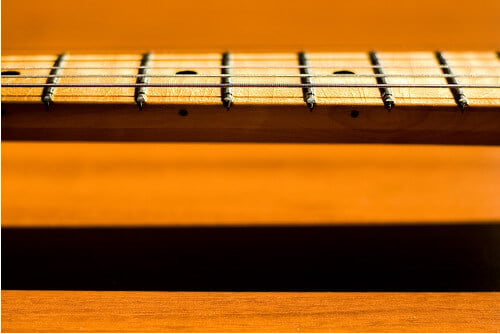Table of Contents
Chances are you are either experiencing an issue with your guitar or looking to learn how to maintain it. You have probably heard the term guitar neck relief, but don’t know what it refers to.
Guitar neck relief is the amount of bow that sets the space between the strings and the fretboard. This bow or bend in the neck is intentional and is set by adjusting the truss rod. A properly set-up guitar will have enough neck relief to prevent buzzing. It will also make strings easy to press.
In this article, we are going to look at what is involved in a proper setup. We will also show how guitar neck relief is incredibly important.
Related articles:
What is Guitar Neck Relief?
Guitar neck relief is the measurement taken between the strings and the fretboard. This is an important measurement, as if the space is too large, the strings will be very hard to press. But if it’s not large enough, the strings will buzz on the frets.
While there are many measurements for neck relief, this is different for most guitars. Not only does it differ between instruments, but the condition of the guitar is also part of the equation. Not only that, but the neck radius dictates what the optimal measurement should be as well.
If you own a Fender Stratocaster the measurement may be different based on the radius.
| Neck Radius | Relief |
|---|---|
| 7.25″ | 0.012″ |
| 9.5″ to 12″ | 0.010″ |
| 15″ to 17″ | 0.008″ |
How Do You Set Neck Relief?
The amount of space or neck relief is set by a part called a truss rod. This is installed into a channel in the neck and mounted at both ends. The truss rod is usually made of steel, but other materials are used in some instances.
When your strings are tightened, they pull the neck into a bow. The tension would eventually make the guitar unplayable if there was not a truss rod. It’s the force of the rod that compensates for the tension and sets the bow or relief.
Have you ever noticed the small cover on your headstock above the nut? Underneath is an adjustment for your truss rod. Now there are many types and ways they are mounted, especially between instruments. But the idea is the same.
Want to learn more about bolt-on vs set necks? Click Here!
Guitar Neck Bow vs Straight
Some guitars have a neck that looks straight and others do not. There are many factors that need to be considered. For example, the condition and setting of other parts of the guitar.
A properly set up guitar will look pretty straight, but will still have a slight bow. If the neck was perfectly straight, the chance of developing fret buzz is greater. So you should always expect to see a slight relief or bow for optimal results. A good guitar technician will know what to look for when setting up your instrument.

How Straight Should a Guitar Neck Be?
For most guitars, the neck will need to be as straight as possible to allow for the correct string height. This can be different in some cases where a neck may not look straight at all but play perfectly fine. Some guitars will only get so close, depending on the quality of the instrument.
Turning the truss rod too much will mean that the neck may be overly tight and bow the wrong way. So it’s necessary to use the right gauges to measure the relief. Try not to depend on the visual straightness of the neck.
This also depends on the string tension. Should the string thickness be changed, the relief may need to be adjusted as well. And so a straight neck doesn’t mean a correct relief adjustment.
How to Measure Guitar Neck Relief
You don’t have to know how to set the relief to do a check-up on your guitar. It’s a very simple thing to measure. Your guitar can be affected by environmental conditions. The first place you would notice this would be in the neck.
So it’s a good idea to learn how to check the neck relief and know when it might be time to take it in to see your tech. To perform this measurement, you don’t need a fancy guitar neck relief tool that might be hard to get or expensive. You can do this simply using a capo and some feeler gauges.
We recommend these feeler gauges at Amazon. Click Here if you need some.
To begin, put a capo on the first fret and hold the guitar comfortably in your lap or on a flat tabletop. Next, prepare a feeler gauge. We normally recommend using the gauge measuring ten thousandths of an inch (0.010″).
Now fret the Low E string at the 17th or where the neck meets the body. Measure the space between the string and the 7th fret. If the gauge lifts the string, it’s too close to the fretboard. If there is a lot of extra space between the gauge and the string, it’s too far away.
This measurement doesn’t have to be perfect, let’s face it, we are adjusting a wooden neck with a feeler gauge. You are using this method to see if the distance is out considerably from the feeler gauge thickness.

Guitar Neck Relief Gauge
Stewmac has made a gauge that can help you make the adjustment with precision. The device sits on top of the neck and uses a dial indicator to measure the relief.
As you adjust the neck, the reading will reflect how much it is out. This allows for faster adjustments and accurate readings. If you change string thickness often or do many adjustments, it might be a worthwhile tool to have.
Guitar Neck Relief Specifications
Manufacturers provide specs on how much relief their guitars should have. But when trying to align a piece of wood so accurately, you will not always get optimal results. Some people also prefer their relief to be outside the recommended settings. But this is something you realize with experience.
You should stick as close to the recommendation as possible. There is a general rule of thumb for both acoustic and electric guitars. For an acoustic, the neck relief will be far greater. And so don’t try and set up an acoustic the same way you would an electric guitar.
- The acoustic neck relief should be around .015 to .030”.
- The electric around .010 to .012”.
These measurements are a rough rule of thumb, and so the uniqueness of the guitar may change these. If your measurement is any smaller than these, you’re probably too close and the strings will buzz.
Adjusting Guitar Neck Relief
In order to adjust the neck relief, you need to turn the truss rod. If your measurement is greater than the size of the feeler gauge, you will need to tighten the truss rod. If it’s smaller, loosen it.
The amount to turn the truss rod is the tricky part and the result will normally take time. When you make an adjustment, the neck will need time to adjust. Remember, the wood itself has to adapt to the change. This can take a night or two to fully realize.
So we recommend you turn your truss rod ⅛ – ¼ inch and then leave it for the night. You don’t want to make any large changes. And because there are many truss rods, be sure to find out what you have and how to properly operate it.
Low Guitar String Height
Anyone who plays quick solos knows that a lower action is not only more comfortable, but fast! If it’s hard to press your strings, then it will slow you down.
In order to get the correct neck relief, you will need to acquire the right tools. Either that or have a technician set up your guitar. Without the correct adjustment, your strings might be higher than you would like. And so if you want low action, it might be a good idea to learn how to adjust your neck.
This is after all a calibration that might need to be made more often. Especially if you change string thickness often or have drastic seasonal changes.
A properly set neck relief is the first step to allow you to get as close to the frets as possible. Without creating fret buzz as you play. If you find that your strings are high, use the method we spoke of above with a tool to help measure the gap.
Once you find the correct adjustment, try getting a bit closer. If you find that your strings buzz when you play, or choke out when you bend, then back it off. If they do not, then you know a lower string height is possible.

Does Neck Relief Affect Intonation?
Intonation is directly affected by the height of your strings. The guitar’s action is the distance between the strings and the fretboard. Because the neck relief will also adjust this distance, it can impact your intonation.
There are a lot of people who set up their guitar intonation without considering the neck relief. But setting up the instrument has to be done right in an order of operations.
All structural adjustments should be completed First. Well before adjusting things like string height or intonation. You want your guitar to play its best.
It’s like setting your string height before properly balancing a tremolo bridge. This simply does not work and will require you to do it again. So it’s best to start at the beginning.
Visit a Guitar Technician If In Doubt
Around here, we believe that part of your inspiration comes from a good instrument. It’s hard to want to practice if your guitar is in bad shape! Especially if the strings are hard to press. And so if you are just getting started, we encourage you to find a good tech.
Setting your neck relief will also require you to adjust other things on the guitar. And it’s tough to know where to start when you’re a beginner. Many techs have years of experience and are willing to let you watch them perform their service.
In many cases, they will also teach you a few things you can do to maintain your guitar. This is a win when you’re just learning.
So if you perform the neck relief measurement and find its way out, leave it at that and call your technician. Performing the measurement and making the adjustment are very different procedures. Especially if your neck has dried out and shrunk due to lack of moisture!
FAQs
How much relief should a guitar neck have?
The amount of relief for both electric and acoustic guitars should be between 8 – 10 thousandths of an inch. This depends on how hard you play and if the strings buzz against the frets. If they do, consider increasing the amount of space between your strings and the frets.
The perfect amount of relief also allows you to press the strings without too much effort. And so getting this setting right is important.
Does neck relief affect string height?
Yes, neck relief has a large impact on string height. If the neck is too straight, this could create buzz. This is because the strings will be too close to the frets. It’s also known as a convex bow. If the neck is overly curved, the strings will be too high off of the fretboard. But this depends on the extent of the concave bow.

